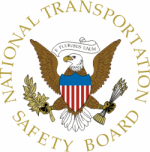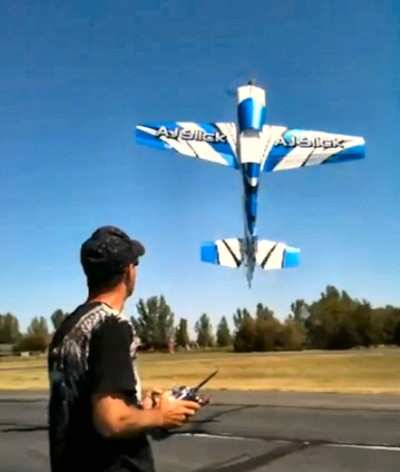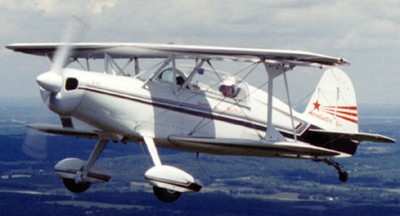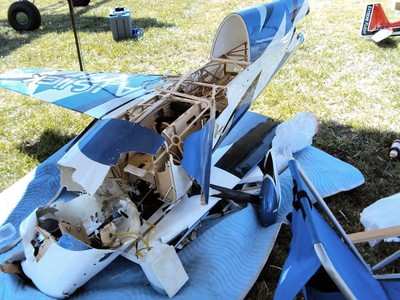Radio Controlled Plane Was Performing In A Model Air Show.
 In what was perhaps the most
unusual mid-air collision last year, a Shpakow SA 750 bipe struck a
large-scale AJ Slick RC model, slightly damaging the larger
aircraft but largely destroying the model. The good news is that
the biplane landed safely, but it was not undamaged.
In what was perhaps the most
unusual mid-air collision last year, a Shpakow SA 750 bipe struck a
large-scale AJ Slick RC model, slightly damaging the larger
aircraft but largely destroying the model. The good news is that
the biplane landed safely, but it was not undamaged.
NTSB Identification: CEN10LA487A
14 CFR Part 91: General Aviation
Accident occurred Saturday, August 14, 2010 in Brighton, CO
Aircraft: SHPAKOW THOMAS SA 750, registration: N28KT
Injuries: 2 Uninjured.
On August 14, 2010, approximately 1100 mountain daylight time,
N28KT, a Shpakow SA 750 bi-plane, was substantially damaged when it
collided with a radio controlled AJ Slick airplane, while
performing a go-around at the Van-Aire Estates Airport (CO12),
Brighton, Colorado. Visual meteorological conditions prevailed at
the time of the accident. The personal flight was being conducted
under the provisions of 14 Code of Federal Regulations Part 91
without a flight plan. The pilot and his passenger were not
injured. The flight departed Centennial Airport (KAPA), Denver,
Colorado, approximately 1030, and was destined for Brighton,
Colorado.

AJ Slick Model Hover
According to a telephone conversation and subsequent written
statement submitted by the pilot of the bi-plane, he was flying to
CO12 to participate in a fly-in and BBQ event. Prior to his flight,
he had contacted the event organizer, coordinated his arrival, and
received a briefing that there would be radio controlled airplane
models flying between 1000 and 1400. While on approach to runway
12, he observed a Cessna airplane on the runway and performed a
go-around. During his second approach to runway 12, he felt that
his approach speed was fast, and the airplane was not aligned
properly so he added power, turned his smoke on to increase
visibility to the radio controlled airplane operators, and
announced that he was performing a go-around.
While performing the go-around, the radio controlled airplane
impacted the lower left wing of the bi-plane. The pilot of the
bi-plane reported that he lost altitude but was able to recover and
land the bi-plane without further incident. He stated that he did
not see the radio controlled airplane until just prior to the
impact.
The FAA inspector who examined the bi-plane reported that lower
left wing was crushed aft to the main spar. A six to eight inch
tear was noted in the upper left wing fabric, and damage was noted
on the leading edge of the left aileron.
According to a telephone conversation and subsequent written
statement submitted by the pilot of the radio controlled airplane,
he had been cleared by the “air boss” to exhibit his
airplane in flight. He understood that the event coordinator (air
boss) was providing see and avoid assistance and communicating with
airplanes flying in and out of the airport. The pilot of the radio
controlled airplane reported that during his routine, the bi-plane
came from out of nowhere and “slammed” into his radio
controlled airplane. He reported that his airplane was
destroyed.

Shpakow Acroduster SA 750
During the event, a video was made of the radio controlled
airplane performance. The video captured the events prior to the
collision, as well as the collision between the radio controlled
airplane and the bi-plane. The beginning of the video showed the
radio controlled airplane being operated directly over the runway
environment with the operator on the runway, very close to the
airplane. The airplane was in a nose high, tail low attitude,
“hanging” on the propeller. Approximately 35 seconds
into the video, a second individual carrying a hand-held radio is
seen walking towards the radio controlled airplane operator. Due to
the engine noise, their conversation could not be heard. At this
time, the radio controlled airplane recovered from the maneuver and
climbed in altitude. The next frame showed the accident bi-plane
flying from the left side of the screen to the right side of the
screen. At 38 seconds into the video, the radio controlled airplane
collided with the bi-plane.
In an interview with the event coordinator, he clarified that
the title of airboss was not a formal position. He did provide a
safety briefing with the radio controlled airplane operators the
morning of the event. In this briefing he emphasized that only one
aircraft was to fly at a time, they were to fly on the east side of
the runway, not over the runway, and no one was to fly without
first speaking to him. He carried a radio with him to monitor
traffic.
The event coordinator stated that prior to the accident, the
radio controlled airplane operator departed after waiting for a
Cessna to land. Shortly thereafter the bi-plane reported that he
was intending to land and the event coordinator asked him to report
3 miles out. The radio controlled airplane flew away from the
airport towards the east. When the bi-plane reported that he was on
final, the event coordinator became aware that the radio controlled
airplane was over the runway performing stunts and hovers. When the
bi-plane announced his go-around, the event coordinator realized
that the radio controlled airplane was in the bi-planes flight path
and told the radio controlled airplane operator to “dump
it.” The radio controlled airplane continued to hover for a
few seconds and then initiated an escape maneuver which placed the
radio controlled airplane in the bi-plane’s flight path. The
event coordinated maintained that he was not acting in the capacity
of a spotter.
The club president reported that this was not an Academy of
Model Aeronautics (AMA) sanctioned event; however, AMA rules
applied. He had understood that the individual creating the video
was also the spotter; however, he was not sure if a spotter had
been formally or officially assigned.

Model After Collision
The AMA Safety Code stated that model aircraft pilots should
yield right of way to all man carrying aircraft, see and avoid all
aircraft, and utilize a spotter when appropriate. In a follow-up
conversation with a representative with the AMA, it is left up to
the operator to use a spotter, and there is not currently any
guidance for spotter briefings, or spotter responsibilities. The
“See and Avoid Guidance” on the AMA websites stated
that the spotter should understand their duties and expectations,
and should be used when operation is expected within the proximity
of manned aircraft. The AMA does not advise concurrent
operations.
The Federal Aviation Administration Advisory Circular (AC)
91-57, Model Aircraft Operating Standards, stated that operators
should give right of way to, and avoid flying in the proximity of,
full-scale aircraft. The AC also encourages operators to use
observers to help.
 Aero-News: Quote of the Day (04.27.25)
Aero-News: Quote of the Day (04.27.25) ANN's Daily Aero-Linx (04.27.25)
ANN's Daily Aero-Linx (04.27.25) Classic Aero-TV: Veteran's Airlift Command -- Serving Those Who Served
Classic Aero-TV: Veteran's Airlift Command -- Serving Those Who Served Airborne-NextGen 04.22.25: NYC eVTOL Network, ForgeStar-1, Drone Safety Day
Airborne-NextGen 04.22.25: NYC eVTOL Network, ForgeStar-1, Drone Safety Day Airborne 04.21.25: Charter Bust, VeriJet Woes, Visual Approach Risks
Airborne 04.21.25: Charter Bust, VeriJet Woes, Visual Approach Risks






